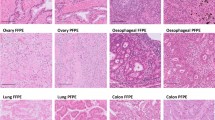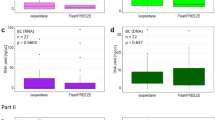Abstract
Purpose of Review
Formalin-fixed, paraffin-embedded (FFPE) tissue blocks are considered by some to be suboptimal for Next Generation Sequencing (NGS) because, compared with fresh-frozen (FF) biospecimens, the nucleic acid obtained from them is fragmented and low in quantity, containing formalin-induced modifications and mutations. However, clinical workflows do not typically have the capability to collect FF tissue, so there is an inherent necessity to perform NGS using FFPE tissue. We review relevant literature that addresses the issue of extracting DNA from FFPE tissue biospecimens then applying it to NGS.
Recent Findings
Practical and straightforward optimisation experiments and quality control assays can be performed by laboratories who extract DNA from FFPE biospecimens to maximise its amenability to NGS.
Summary
FFPE biospecimens can be used in genomic medicine with confidence because the disadvantages associated with DNA quality are outweighed by the ease of sample collection and can be addressed by protocol optimisation.
Similar content being viewed by others
References
Fox EJ, Reid-Bayliss KS, Emond MJ, Loeb LA. Accuracy of next generation sequencing platforms. Next Gener Seq Appl. 2014;1. https://doi.org/10.4172/jngsa.1000106.
Spencer DH, Sehn JK, Abel HJ, Watson MA, Pfeifer JD, Duncavage EJ. Comparison of clinical targeted next-generation sequence data from formalin-fixed and fresh-frozen tissue specimens. J Mol Diagn. 2013;15(5):623–33. https://doi.org/10.1016/j.jmoldx.2013.05.004.
Kim S, Park C, Ji Y, Kim DG, Bae H, van Vrancken M, et al. Deamination effects in formalin-fixed, paraffin-embedded tissue samples in the era of precision medicine. J Mol Diagn. 2017;19(1):137–46. https://doi.org/10.1016/j.jmoldx.2016.09.006.
Schweiger MR, Kerick M, Timmermann B, Albrecht MW, Borodina T, Parkhomchuk D, et al. Genome-wide massively parallel sequencing of formaldehyde fixed-paraffin embedded (FFPE) tumor tissues for copy-number- and mutation-analysis. PLoS One. 2009;4(5):e5548. https://doi.org/10.1371/journal.pone.0005548.
Annaratone L, Marchio C, Russo R, Ciardo L, Rondon-Lagos SM, Goia M, et al. A collection of primary tissue cultures of tumors from vacuum packed and cooled surgical specimens: a feasibility study. PLoS One. 2013;8(9):e75193. https://doi.org/10.1371/journal.pone.0075193.
Zsikla V, Baumann M, Cathomas G. Effect of buffered formalin on amplification of DNA from paraffin wax embedded small biopsies using real-time PCR. J Clin Pathol. 2004;57(6):654–6.
Prentice LM, Miller RR, Knaggs J, Mazloomian A, Hernandez RA, Franchini P, et al. Formalin fixation increases deamination mutation signature but should not lead to false positive mutations in clinical practice. PLoS One. 2018;13(4):e0196434. https://doi.org/10.1371/journal.pone.0196434.
Millan-Esteban D, Reyes-Garcia D, Garcia-Casado Z, Banuls J, Lopez-Guerrero JA, Requena C, et al. Suitability of melanoma FFPE samples for NGS libraries: time and quality thresholds for downstream molecular tests. Biotechniques. 2018;65(2):79–85. https://doi.org/10.2144/btn-2018-0016.
Hedegaard J, Thorsen K, Lund MK, Hein A-MK, Hamilton-Dutoit SJ, Vang S, et al. Next-generation sequencing of RNA and DNA isolated from paired fresh-frozen and formalin-fixed paraffin-embedded samples of human cancer and normal tissue. PLoS One. 2014;9(5):e98187-e. https://doi.org/10.1371/journal.pone.0098187.
Gjerdrum LM, Abrahamsen HN, Villegas B, Sorensen BS, Schmidt H, Hamilton-Dutoit SJ. The influence of immunohistochemistry on mRNA recovery from microdissected frozen and formalin-fixed, paraffin-embedded sections. Diagn Mol Pathol. 2004;13(4):224–33.
Whetsell L, Maw G, Nadon N, Ringer DP, Schaefer FV. Polymerase chain reaction microanalysis of tumors from stained histological slides. Oncogene. 1992;7(11):2355–61.
Frazer Z, Sroya M, Bellora C, Betsou F, DeWitt B, Mathieson W, et al. Optimizing a protocol for DNA extractions from FFPE tissue: different Proteinase K digests and deparaffinization in centrifuge tubes or on microscope slides. Biopreservation and Biobanking. 2017;15(3):A-23.
Schmeller J, Wessolly M, Mairinger E, Borchert S, Hager T, Mairinger T, et al. Setting out the frame conditions for feasible use of FFPE derived RNA. Pathol Res Pract. 2019;2018. https://doi.org/10.1016/j.prp.2018.12.027.
Tian SK, Killian JK, Rekhtman N, Benayed R, Middha S, Ladanyi M, et al. Optimizing workflows and processing of cytologic samples for comprehensive analysis by next-generation sequencing: Memorial Sloan Kettering Cancer center experience. Arch Pathol Lab Med. 2016;140:1200–5. https://doi.org/10.5858/arpa.2016-0108-RA.
Kikuchi A, Sawamura T, Daimaru O, Horie M, Sasaki K, Okita N. Improved protocol for extraction of genomic DNA from formalin-fixed paraffin-embedded tissue samples without the use of xylene. Clin Chem Lab Med. 2016;54(12):E375–E7. https://doi.org/10.1515/cclm-2016-0108.
Robbe P, Popitsch N, Knight SJL, Antoniou P, Becq J, He M, et al. Clinical whole-genome sequencing from routine formalin-fixed, paraffin-embedded specimens: pilot study for the 100,000 Genomes Project. Genet Med. 2018;20:1196–205. https://doi.org/10.1038/gim.2017.241.
Senguven B, Baris E, Oygur T, Berktas M. Comparison of methods for the extraction of DNA from formalin-fixed, paraffin-embedded archival tissues. Int J Med Sci. 2014;11(5):494–9. https://doi.org/10.7150/ijms.8842.
Arbeithuber B, Makova KD, Tiemann-Boege I. Artifactual mutations resulting from DNA lesions limit detection levels in ultrasensitive sequencing applications. DNA Res. 2016;23(6):547–59. https://doi.org/10.1093/dnares/dsw038.
Janecka A, Adamczyk A, Gasinska A. Comparison of eight commercially available kits for DNA extraction from formalin-fixed paraffin-embedded tissues. Anal Biochem. 2015;476:8–10. https://doi.org/10.1016/j.ab.2015.01.019.
Kennedy-Darling J, Smith LM. Measuring the formaldehyde protein-DNA cross-link reversal rate. Anal Chem. 2014;86(12):5678–81. https://doi.org/10.1021/ac501354y.
Shi SR, Cote RJ, Wu L, Liu C, Datar R, Shi Y, et al. DNA extraction from archival formalin-fixed, paraffin-embedded tissue sections based on the antigen retrieval principle: heating under the influence of pH. J Histochem Cytochem. 2002;50(8):1005–11. https://doi.org/10.1177/002215540205000802.
Lu XJD, Liu KYP, Zhu YS, Cui C, Poh CF. Using ddPCR to assess the DNA yield of FFPE samples. Biomol Detect Quantif. 2018;16:5–11. https://doi.org/10.1016/j.bdq.2018.10.001.
Bonnet E, Moutet ML, Baulard C, Bacq-Daian D, Sandron F, Mesrob L, et al. Performance comparison of three DNA extraction kits on human whole-exome data from formalin-fixed paraffin-embedded normal and tumor samples. PLoS One. 2018;13(4):e0195471. https://doi.org/10.1371/journal.pone.0195471.
Heydt C, Fassunke J, Kunstlinger H, Ihle MA, Konig K, Heukamp LC, et al. Comparison of pre-analytical FFPE sample preparation methods and their impact on massively parallel sequencing in routine diagnostics. PLoS One. 2014;9(8):e104566. https://doi.org/10.1371/journal.pone.0104566.
Mathieson W, Guljar N, Sanchez I, Sroya M, Thomas GA. Extracting DNA from FFPE tissue biospecimens using user-friendly automated technology: is there an impact on yield or quality? Biopreservation and Biobanking. 2018;16:191–9. https://doi.org/10.1089/bio.2018.0009.
Huijsmans CJ, Damen J, van der Linden JC, Savelkoul PH, Hermans MH. Comparative analysis of four methods to extract DNA from paraffin-embedded tissues: effect on downstream molecular applications. BMC research notes. 2010;3:239. https://doi.org/10.1186/1756-0500-3-239.
Sam SS, Lebel KA, Bissaillon CL, Tafe LJ, Tsongalis GJ, Lefferts JA. Automation of genomic DNA isolation from formalin-fixed, paraffin-embedded tissues. Pathol Res Pract. 2012;208(12):705–7. https://doi.org/10.1016/j.prp.2012.08.008.
Jacobs S, Thompson ER, Nannya Y, Yamamoto G, Pillai R, Ogawa S, et al. Genome-wide, high-resolution detection of copy number, loss of heterozygosity, and genotypes from formalin-fixed, paraffin-embedded tumor tissue using microarrays. Cancer Res. 2007;67(6):2544–51. https://doi.org/10.1158/0008-5472.CAN-06-3597.
Khokhar SK, Mitui M, Leos NK, Rogers BB, Park JY. Evaluation of Maxwell(R) 16 for automated DNA extraction from whole blood and formalin-fixed paraffin embedded (FFPE) tissue. Clin Chem Lab Med. 2011;50(2):267–72. https://doi.org/10.1515/CCLM.2011.763.
Sanchez I, Remm M, Frasquilho S, Betsou F, Mathieson W. How severely is DNA quantification hampered by RNA co-extraction? Biopreserv Biobank. 2015;13(5):320–4. https://doi.org/10.1089/bio.2015.0008.
Mathieson W, Thomas GA. Simultaneously extracting DNA, RNA, and protein using kits: is sample quantity or quality prejudiced? Anal Biochem. 2013;433(1):10–8. https://doi.org/10.1016/j.ab.2012.10.006.
Radpour R, Sikora M, Grussenmeyer T, Kohler C, Barekati Z, Holzgreve W, et al. Simultaneous isolation of DNA, RNA, and proteins for genetic, epigenetic, transcriptomic, and proteomic analysis. J Proteome Res. 2009;8(11):5264–74. https://doi.org/10.1021/pr900591w.
Katevatis C, Fan A, Klapperich CM. Low concentration DNA extraction and recovery using a silica solid phase. PLoS One. 2017;12(5):e0176848. https://doi.org/10.1371/journal.pone.0176848.
Doran AE, Foran DR. Assessment and mitigation of DNA loss utilizing centrifugal filtration devices. Forensic Sci Int Genet. 2014;13:187–90. https://doi.org/10.1016/j.fsigen.2014.08.001.
Garvin AM, Fritsch A. Purifying and concentrating genomic DNA from mock forensic samples using Millipore Amicon filters. J Forensic Sci. 2013;58(Suppl 1):S173–5. https://doi.org/10.1111/1556-4029.12002.
Sanchez I, Betsou F, Mathieson W. Does vacuum centrifugal concentration reduce yield or quality of nucleic acids extracted from FFPE biospecimens? Anal Biochem. 2018; in press.
Sedlackova T, Repiska G, Celec P, Szemes T, Minarik G. Fragmentation of DNA affects the accuracy of the DNA quantitation by the commonly used methods. Biological Procedures Online. 2013;15. https://doi.org/10.1186/1480-9222-15-5.
Desjardins P, Conklin D. NanoDrop microvolume quantitation of nucleic acids. J Vis Exp. 2010;(45). https://doi.org/10.3791/2565.
Sah S, Chen L, Houghton J, Kemppainen J, Marko AC, Zeigler R, et al. Functional DNA quantification guides accurate next-generation sequencing mutation detection in formalin-fixed, paraffin-embedded tumor biopsies. Genome Med. 2013;5(8):77. https://doi.org/10.1186/gm481.
Wang FF, Wang LL, Briggs C, Sicinska E, Gaston SM, Mamon H, et al. DNA degradation test predicts success in whole-genome amplification from diverse clinical samples. J Mol Diagn. 2007;9(4):441–51. https://doi.org/10.2353/jmoldx.2007.070004.
van Beers EH, Joosse SA, Ligtenberg MJ, Fles R, Hogervorst FBL, Verhoef S, et al. A multiplex PCR predictor for aCGH success of FFPE samples. Br J Cancer. 2006;94(2):333–7. https://doi.org/10.1038/sj.bjc.6602889.
Greytak SR, Engel KB, Zmuda E, Casas-Silva E, Guan P, Hoadley KA, et al. National Cancer Institute biospecimen evidence-based practices: harmonizing procedures for nucleic acid extraction from formalin-fixed, paraffin-embedded tissue. Biopreserv Biobank. 2018;16(4):247–50. https://doi.org/10.1089/bio.2018.0046.
Astolfi A, Urbini M, Indio V, Nannini M, Genovese CG, Santini D, et al. Whole exome sequencing (WES) on formalin-fixed, paraffin-embedded (FFPE) tumor tissue in gastrointestinal stromal tumors (GIST). BMC Genomics. 2015;16:892. https://doi.org/10.1186/s12864-015-1982-6.
Serizawa M, Yokota T, Hosokawa A, Kusafuka K, Sugiyama T, Tsubosa Y, et al. The efficacy of uracil DNA glycosylase pretreatment in amplicon-based massively parallel sequencing with DNA extracted from archived formalin-fixed paraffin-embedded esophageal cancer tissues. Cancer Gene Ther. 2015;208(9):415–27. https://doi.org/10.1016/j.cancergen.2015.05.001.
Darwanto A, Hein AM, Strauss S, Kong Y, Sheridan A, Richards D, et al. Use of the QIAGEN GeneReader NGS system for detection of KRAS mutations, validated by the QIAGEN Therascreen PCR kit and alternative NGS platform. BMC Cancer. 2017;17(1):358. https://doi.org/10.1186/s12885-017-3328-z.
Bourgon R, Lu S, Yan Y, Lackner MR, Wang W, Weigman V, Wang D, Guan Y, Ryner L, Koeppen H, Patel R, Hampton GM, Amler LC, Wang Y High-throughput detection of clinically relevant mutations in archived tumor samples by multiplexed PCR and next-generation sequencing. Clinical cancer research : an official journal of the American Association for Cancer Research 2014;20(8):2080–2091. doi:https://doi.org/10.1158/1078-0432.CCR-13-3114.
Heyn P, Stenzel U, Briggs AW, Kircher M, Hofreiter M, Meyer M. Road blocks on paleogenomes--polymerase extension profiling reveals the frequency of blocking lesions in ancient DNA. Nucleic Acids Res. 2010;38(16):e161. https://doi.org/10.1093/nar/gkq572.
Author information
Authors and Affiliations
Corresponding author
Ethics declarations
Conflict of Interest
The authors declare that they have no conflict of interest.
Human and Animal Rights and Informed Consent
This article does not contain any studies with human or animal subjects performed by any of the authors.
Additional information
Publisher’s Note
Springer Nature remains neutral with regard to jurisdictional claims in published maps and institutional affiliations.
This article is part of the Topical Collection on Biospecimens Science and Evidence-Based Standards for Precision Medicine
Rights and permissions
About this article
Cite this article
Mathieson, W., Thomas, G. Using FFPE Tissue in Genomic Analyses: Advantages, Disadvantages and the Role of Biospecimen Science. Curr Pathobiol Rep 7, 35–40 (2019). https://doi.org/10.1007/s40139-019-00194-6
Published:
Issue Date:
DOI: https://doi.org/10.1007/s40139-019-00194-6




